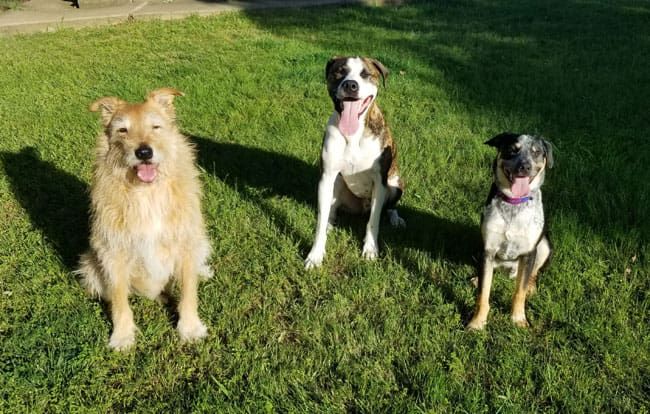My trainer friend Sarah Richardson, owner of The Canine Connection in Chico, California, recently attended a conference in Hot Springs, Arkansas, with a world-renowned pioneer in animal training. She came back home full of inspiration and excitement, with ideas about how she wants to add things and change things in her group training classes.
Sarah hosts a discussion group on Facebook for her training clients, and she posted this shortly after she got back:
“Bob Bailey is now in his 80s but was literally one of the first in the world to be training as we now do with operant conditioning, use of a marker, etc. Bob invited some of the key people he has influenced to serve as his fellow presenters and they came from Canada, Holland, Germany, Mexico, and the US to be with him.
“One of the presenters gave a talk about how ballet improved her dog training. As an adult in her 40s, she took up ballet and learned how hard it is to do the basic movements really well. In contrast, world-class ballerinas practice the basic movements – just the basics – up to 8 hours a day! It got me thinking: How much do we practice the basics – just the basics! – with our dogs so that they are competent with these core skills, and so we are competent with teaching and communicating with our dogs?
“So, I am returning home from my trip with a challenge for myself and my dogs. We are going to return to practicing our canine calisthenics – sit, down, stand – like crazy, in short, frequent training sessions this month. My goal is for my dogs to do these behaviors on a verbal cue as well as on a hand signal and in many different contexts (how they are positioned in relation to me, the setting we are in, etc.).”
Further, Sarah encouraged those in the group to practice and post video of their practice sessions with their dogs.
Time to Start Practicing
I thought I would take the challenge. Back to basics – easy peasy, yes? Both of my dogs know hand and verbal cues for sit, down, and stand, and can readily move from one position to the other. My senior dog Otto is super sharp at these, and eagerly demonstrates his acuity. I looked forward to taking some video of Otto confidently moving through these exercises to share with the discussion group.

I thought (correctly) that I would have to practice more with my younger dog, Woody, before I could commit to putting our efforts on video. Woody takes a more speculative approach to my cues. “Why are you asking?” he seems to say when I give him a cue. He “knows” the cues for sit, down, and stand. After taking a moment to determine whether I’m serious about wanting a response from him, he will methodically change from any one of those positions to any other position. But he tends to get stuck a few position changes into any session of more than three requests. He needs some convincing that the work is worth his while. He may go into a down, and then just stay there after I ask for “sit” or “stand.” His expression seems to say, “I’m just not sure there is a point to all this!”
Food treat rewards increase the motivation – and I don’t blame him one bit. I don’t like working for zero pay, either. And his speed definitely increases when the compensation value increases; he will work longer and faster for chicken or cheese than kibble. But he only gets enthusiastic and sharp-looking if the “pay” is his highest-value reward: a chance to go fetch his Planet Dog Squeak ball.

“What’s In It For Me?”
Woody’s deliberations make me miss my Border Collie, Rupert – the dog I owned when we launched Whole Dog Journal 22 years ago. Well-trained Border Collies make any trainer look good; they love to work and find it incredibly self-rewarding to respond to rapid-fire cues. Many will work without treats or any other tangible reward; the opportunity to work with their person is often enough of a high-value reinforcement in itself! In contrast, Woody, a pit-Lab-mix, has a healthy self-preservation instinct. He wants to know, “What’s in it for me?” before committing himself to a lot of training nonsense.
Otto is somewhere in between. He’s keen to earn my praise and attention, and he likes food treats. But he’s not going to do this all day. I have to keep our practice sessions short and fun, or he starts dramatically sighing and moaning on his “downs” – or looking off to the side when I first give him a cue, like, “Wait, one sec… Did you just hear the mail truck? I think maybe I should go check to see if your mail is here…”
Anyway, I’ve been practicing. I took video on Otto’s first session, and it wasn’t bad. As I predicted, he is really pretty sharp and willing – though the fact that I was holding a camera/phone between us was definitely off-putting to him. And after a dozen or so position changes he was like, “Um, Nance… What’s going on here?”
It took a couple days of practice before I even bothered to try to take some footage of Woody’s efforts. The fact that I recently brought home a nice new Squeak ball helped a lot.
I do tend to take these basic behaviors for granted from my own dogs, but practicing with the goal of taking video that I could share has been fun. It also gives me and my dogs something to “talk about” – an extra few interactions each day that are (I hope) mutually enjoyable. Try it yourself! We’ll put a post on the WDJ Facebook page where you can upload video of your own dogs doing these basic exercises.





